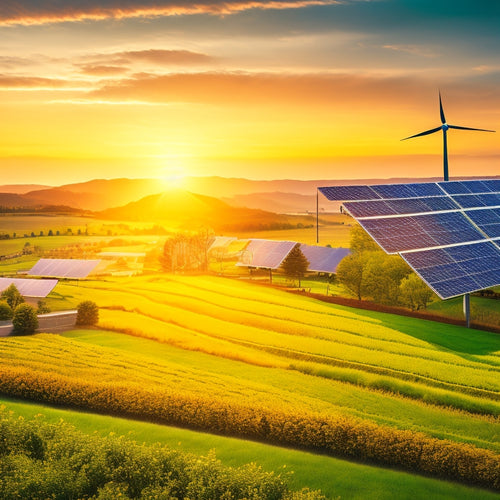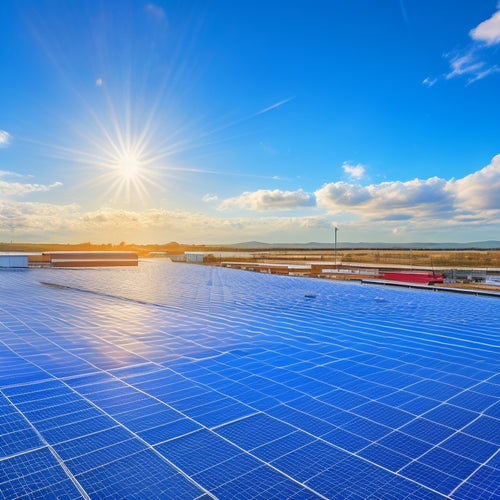
Lighting Your Home With Renewable Energy Systems
Share
You're taking an essential step towards a sustainable home by exploring renewable energy systems. Utilizing solar energy potential is a significant reduction in your reliance on the grid, with high-efficiency solutions utilizing advanced MPPT technology for maximum energy capture. By calculating your energy requirements and choosing the right solar inverter, you can create a system that powers your essential home devices while reducing your electricity bills. With benefits including minimal environmental impact, decreased reliance on fossil fuels, and financial savings, you're on the path to energy independence - and there's more to uncover about optimizing your system's performance and efficiency.
Overview
- High-efficiency solar panels with advanced MPPT technology can significantly reduce reliance on the grid and lower electricity bills.
- Proper installation of solar panels, considering roof size, orientation, and shading, ensures effective utilization of solar energy.
- Solar lighting systems provide long-term cost savings, minimal environmental impact, and reduced carbon footprint, making them an attractive option.
- Accurate calculation of energy requirements, including load analysis and categorization of energy loads, is crucial for designing an efficient solar lighting system.
- Monitoring key performance indicators, such as voltage, current, and power output, helps identify potential issues and ensures a reliable supply of clean energy.
Harnessing Solar Energy Potential
How much of your daily electricity consumption could you offset by utilizing the solar energy potential surrounding your home?
You'd be surprised at the impact solar energy trends can have on your energy independence. Recent solar technology advancements have made it possible to capture a significant portion of your energy needs from the sun, with high-efficiency solutions maximizing energy harvest through advanced MPPT technology.
By leveraging the sun's energy, you can reduce your reliance on the grid and enjoy lower electricity bills. With the right system, you can power your lights, appliances, and even charge your devices using clean, renewable energy, ensuring energy resilience for off-grid living.
Solar Panel Installation Options
You've determined that utilizing solar energy is a viable option for your home lighting needs. Now, it's time to investigate solar panel installation options.
When designing and selecting your solar energy system, it's crucial to select the right solar panels that meet your energy requirements and budget.
You have two primary grid connection options: grid-tied and off-grid systems. Grid-tied systems synchronize with the grid, allowing you to sell excess energy back to the utility company. Off-grid systems, on the other hand, are ideal for remote locations or those seeking energy independence.
When it comes to installation, you can opt for a professional setup or take the DIY route. For DIY installation, make sure you follow local building codes and safety guidelines.
Additionally, consider factors like roof size, orientation, and shading to optimize your solar panel placement. With the right installation, you'll be utilizing the sun's energy in no time.
Benefits of Solar Lighting Systems
Your solar lighting system yields numerous benefits, making it an attractive alternative to traditional energy sources.
You'll enjoy significant cost savings, as solar power is free once the initial installation is complete. This translates to lower electricity bills and a reduced reliance on the grid.
Additionally, solar lighting systems have a minimal environmental impact, producing no emissions or pollution. By utilizing renewable energy, you're reducing your carbon footprint and contributing to a cleaner, healthier planet.
Integration of solar energy significantly decreases reliance on fossil fuels, enhancing energy efficiency and lowering carbon emissions.
With a solar lighting system, you're not only saving money but also doing your part to preserve the environment. This freedom from traditional energy sources and their associated costs and drawbacks is a major advantage of solar lighting systems.
Calculating Energy Requirements
Determining your energy requirements is an important step in designing an effective solar lighting system. To calculate your energy consumption, you'll need to analyze your usage patterns and identify peak hours when energy demand is highest.
Conduct a load analysis to determine the power demand of each home appliance, considering factors like energy efficiency and seasonal variations. This will help you determine the total energy consumption of your home.
Prior to this, it's vital to categorize energy loads into essential, semi-essential, and non-essential for best resource allocation. By doing so, you can prioritize your energy needs and guarantee that your system can handle the maximum power output.
Choosing the Right Solar Inverter
When selecting a solar inverter for your home lighting system, you'll need to take into account two critical factors: inverter efficiency ratings and ideal system sizing.
You'll want to choose an inverter with a high efficiency rating to minimize energy losses and maximize your system's overall performance.
Inverter Efficiency Ratings
In the domain of solar energy systems, the inverter's efficiency rating plays an essential role in optimizing power conversion, as it directly affects the overall performance and energy yield of your solar array.
When selecting an inverter, you'll encounter different types, including string inverters, microinverters, and power optimizers. Each has its own efficiency standards, which can vary depending on factors like temperature and operating conditions.
Look for inverters with high efficiency ratings, typically above 95%, to minimize energy losses. Efficiency standards like CEC (California Energy Commission) and IEC (International Electrotechnical Commission) can guide your selection.
Optimal System Sizing
You need to confirm that your solar inverter is correctly sized to handle the power output of your solar array, as an undersized inverter will result in lost energy and reduced system efficiency.
A correctly sized inverter guarantees peak system performance, maximizing energy optimization and minimizing energy losses.
To determine the right size, calculate your solar array's maximum power output and choose an inverter with a matching or slightly higher capacity.
Consider factors like temperature, shading, and panel orientation, which can affect energy output.
Oversizing the inverter can lead to increased costs, so it's crucial to strike a balance between system performance and cost-effectiveness.
Battery Storage for Nighttime Use
A typical renewable energy system generates power during the day, but what about nighttime use?
You'll need a dependable battery storage system to provide power when the sun goes down. You have several battery types to choose from, including lead-acid, lithium-ion, and nickel-cadmium, each with its own storage capacity and discharge cycles.
Effective energy management is essential to guarantee your system operates efficiently. Look for a system with high charging efficiency to minimize energy loss.
Hybrid systems can also be a viable option, combining different battery types for peak performance.
When selecting a system, consider cost considerations, maintenance practices, and the overall value it provides.
Monitoring Your Solar Power Output
Three key performance indicators (KPIs) determine the health of your solar power system: voltage, current, and power output. You need to monitor these metrics to guarantee your system is operating at peak levels.
Solar output monitoring involves tracking these KPIs to identify potential issues before they impact your energy production. You can use a monitoring system to track your solar power output in real-time, receiving alerts when performance dips below expected levels.
Performance tracking helps you pinpoint areas for improvement, maximizing your energy independence. By keeping a close eye on your system's performance, you'll be able to troubleshoot issues quickly, minimizing downtime and providing a reliable supply of clean energy for your home.
Frequently Asked Questions
Can I Install Solar Panels on My Own Without Professional Help?
You can attempt a DIY solar installation, but be aware that solar panel regulations vary by location, and improper installation may void warranties or even lead to safety hazards, so it's recommended to seek professional help.
Are Solar Lights Compatible With Traditional Lighting Fixtures?
You'll find that most solar light types, like string lights or pathway lights, are compatible with traditional fixture connections, but always check the manufacturer's specs to guarantee seamless integration with your existing setup.
Do Solar Panels Work During Periods of Low Sunlight?
You'll be amazed that solar panels still produce power even on cloudy days! While efficiency takes a hit, modern panels are designed to maximize low sunlight performance, capturing every last photon to keep your lights shining, even on the gloomiest of days.
Can I Use Solar Energy to Power My Entire Home?
You can achieve home energy independence by utilizing solar power, but it depends on your energy needs and solar panel efficiency; with proper system design and installation, you'll be on your way to powering your entire home sustainably.
Are There Any Government Incentives for Solar Energy Systems?
You're wondering if going green comes with a financial perk. Yes, it does! You're eligible for federal tax credits and state rebates when installing solar energy systems, considerably reducing your upfront costs and increasing your return on investment.
Ready to Buy
You've made the switch to renewable energy, and now you're utilizing the power of the sun to light up your home. But you might be thinking, "What about when the sun goes down?" Don't worry, with the right battery storage system, you can enjoy the benefits of solar energy 24/7. By calculating your energy requirements, choosing the perfect solar inverter, and monitoring your power output, you'll be well on your way to a sustainable and energy-independent future.
Related Posts
-

Net Metering in Renewable Energy's Future
Net metering's future is vital for driving renewable energy growth and financial savings. You can reduce your electri...
-

Smart Home Thermostats to Revolutionize Your Space
Smart home thermostats revolutionize your space by providing precise temperature control and optimizing energy saving...
-

Commercial Solar Energy
As you consider powering your business with commercial solar energy, you'll uncover it offers a triple benefit: signi...


